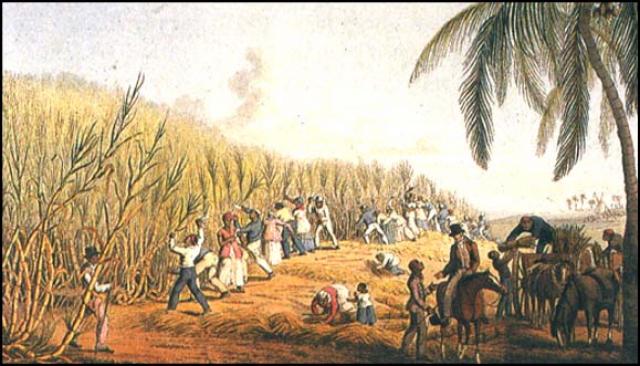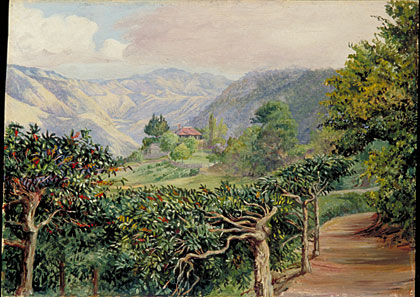Jamaica Blue Mountain Coffee History Chapter Two
Jamaica Blue Mountain Coffee
A Short History
Chapter Two – Coffee is Established in Jamaica
Almost every story of Blue Mountain coffee begins with Governor Lawes (or, as in the first chapter of this effort, with Mathieu de Clieu). Lawes, a man who was married five times, each time to a different, well-connected, widow, is well known for introducing coffee to Jamaica in 1728, but its cultivation did not take off immediately. In 1752 exports amounted to a mere 60,000 pounds.
It was in the late 1700’s that coffee boomed. There were well over 600 plantations at the turn of the century, but by 1850 there were only around 150 left. The story most often told is fast-forwarded to the 20th century and the creation of the Coffee Industry Board to address quality issues besetting the industry. What happened in between? Why did Jamaica produce so much coffee by the end of the 1700’s only to be decimated by the late 1800’s? There is no simple answer, but there appear to be several factors behind the decreased production, including the emancipation of slaves, the general difficulty in finding labor in Jamaica, price fluctuations, and the weather.

Early colonial Jamaica history consisted of constant struggle against the predations of pirates and privateers, and, perhaps more debilitating, a struggle against disease, including malaria, cholera and yellow fever. It was astounding how rampant disease was and the mortality rate, especially of British soldiers stationed in Jamaica, was high. In 1849 Asiatic cholera killed over 30,000 Jamaicans, more than 1 out of every 13 inhabitants of the island.
Against this backdrop agriculture fluctuated over the years. Coffee began to boom in the late 1700’s, as Britain eased tariffs on coffee and consumption in Britain rose significantly. In 1799 there were around six hundred and eight-six plantations with around 70,000 acres under cultivation. When Britain eased tariffs coffee consumption and cultivation boomed. By 1804 Jamaica exported 22,000,000, nearly a 1400% increase over 10 years prior. Production peaked at 80.5 million pounds in 1814 according to Gardner, or 34 million according to Ukers, and there after declined to an average of 22 million per year until 1838. After emancipation of the slaves, during a period of “apprenticeship” created to transition slaves into private laborers, production average only about 6 million pounds per year. The decline was already occurring prior to the abolition of slavery, and may have been exacerbated by other factors including price fluctuations, competition for labor with sugar plantations, and competition with countries that still used slave labor.
Price fluctuations of coffee were just a severe in the 19th century as they are today, but it is interesting to note that Jamaican coffee has fetched a premium on the world market over other coffees from the start of its cultivation. Despite the premium, coffee planters were never as rich as their sugar growing counterparts. They often were heavily indebted, lived on their own plantations (or in nearby Kingston) and price fluctuations only exacerbated their indebted situations. This also may have contributed to the abandonment of many plantations after emancipation.
The sugar plantations also had an advantage over coffee plantations in attracting labor. The cane field worker was allowed to consume as much sugar cane as he wanted during harvest, a tradition held over from slavery. But labor was short in any case as evidenced by the various schemes that the Jamaican government tried in order to increase the island’s population.

All the efforts made to attract labor were generally ineffective: The streets of Madras were swept for “volunteers” but the “coolies” were not “motivated workers” according to reports. Northern Europeans were recruited but died in large numbers in the tropical climate they encountered in Jamaica. The Jamaican government spent considerable sums trying to attract craftsmen and tradesmen, but they often did not survive long against the tropical diseases that afflicted the island.
In addition, getting real understanding of what was going on in agriculture in Jamaica is difficult. The “blue book" reports sent back to Britain were some of the worst from the colonies. Most provide the lack of labor, especially after emancipation, as the reason for the decline in coffee production. But reading about the poor governance of the colony during the 18th Century, the wild swings in commodity prices and the damage that weather and the occasional earthquake caused and the labor shortage may have simply exacerbated the problems in farming coffee.
An interesting fact about Emancipation is that the slaves were not immediately free, unless the slave was under six years old. Complete emancipation was preceded by a period of "apprenticeship". Field workers were apprenticed for four years and skilled workers for two years. The apprentices were to be provided free room and board, and only had to work 40.5 hours per week. The balance of the time they could work for wages (and they could buy themselves out of slavery, whether or not their owner agreed), or tend their own crops. Given that there were few "official" outlets of information available to the slaves, especially if they could not read, many thought the emancipation was rumour. After all, things did not change much in 1834 when they became apprentices. In addition, some were still not convinced they were free even after the end of the apprenticeship period.
There is evidence as well that the early coffee plantations suffered from poor soil maintenance, and coffee output declined on the oldest estates. There is evidence that some of the estates established deep in the Blue Mountains, such as Clydesdale and Sherwood Forest, represent a second wave of coffee plantations that benefited from the knowledge of emigres from Martinique (where coffee was established earlier than in Jamaica. These estates were still producing well into the latter half of the 19th century.
By the dawning of the 20th century Jamaica was producing only about 10 million pounds per year of coffee, not much different than what it is producing today, but was beginning to face serious quality issues.
Chapter Three will take us from the beginning of the 20th Century to the revival of Blue Mountain Coffee in Jamaica.
Bibliography of Chapter 2
“A History of Jamaica” W.J. Gardner 1873,
“A History of Coffee” by Ukers.
"An Archeology of Social Space: Analyzing Coffee Plantations in Jamaica's Blue Mountains" by James A. Delle


